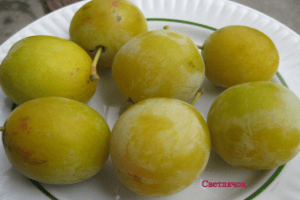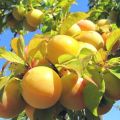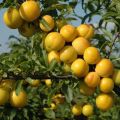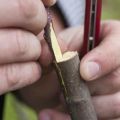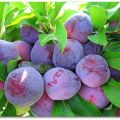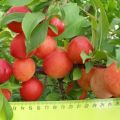Names and symptoms of plum diseases, methods of treatment and preventive measures
Plum is a fruit tree that is susceptible to all diseases. Trees infect fungus, infection, bacteria and non-communicable diseases. Signs of infection appear on leaves and fruits. In order not to miss the onset of the disease, plums are examined during the formation of the crown, buds and fruits. Otherwise, the infection will cover the entire tree and spread to other fruit crops.
Fungal diseases in plum
Plums attack the fungi typical of garden plants and specific fungi that are found on fruit trees.
Coccomycosis
The fungus appears on the leaves in June:
- brown spots on the outside;
- white bloom of a dispute on the back.
Yellow leaves with dots fall off, followed by fruits. The crop does not ripen. Fungal spores live in fallen leaves. To prevent their development in spring, leaves are burned in autumn. The ground of the trunk circle is sprayed with preparations with copper or Bordeaux liquid.
Rust
The causative agent of the disease is a fungus that hibernates in last year's foliage, and in the spring develops on an anemone flower, anemone. The spores of the fungus are transferred to the plum in summer.
How does the disease proceed:
- leaves are covered with light brown spots between veins;
- black myceliums with spores form on the spots;
- the tree loses its foliage, becomes vulnerable to frost and other diseases.
The first rust spots appear in July. At the same time, treatment is started. The tree is sprayed with a 1% solution of Bordeaux mixture or any fungicidal preparations. Then the treatment is repeated every 2 weeks. Disinfection is stopped 3 weeks before fruit ripening. The anemone growing nearby must be destroyed, as spores persist in its rhizome and leaves.
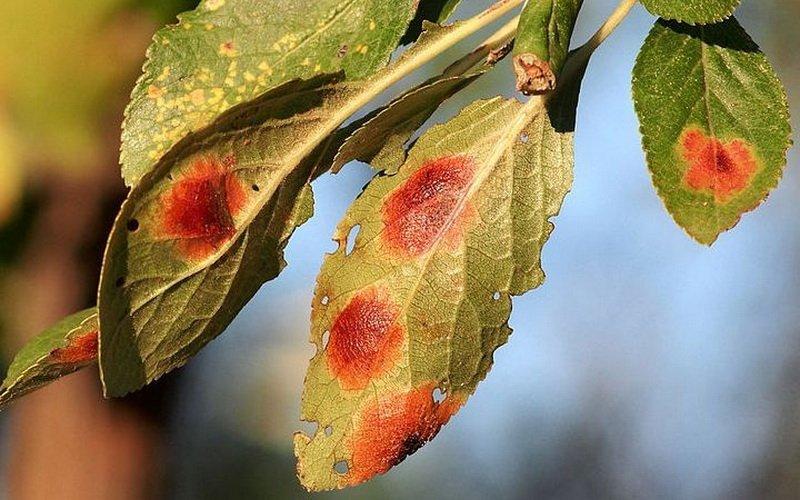
Brown spot
The disease manifests itself in the spring. Signs:
- red-yellow, brown markings on the leaves;
- black spots;
- curling and drying of leaves.
The crown of the tree is crumbling. Fruits rot, do not fully ripen and become deformed.
Brown spot treatment:
- spraying the branches and soil of the trunk circle with a 1% solution of copper sulfate before flowering;
- treatment with 1% Bordeaux liquid 2 weeks after the start of flowering.
The Bordeaux liquid will be replaced by the Hom fungicide. A heavily affected plum orchard is additionally treated 20 days before harvesting.

Plum pockets
Spores of the vocal fungus develop in flowers. Plum orchards get sick with pockets after a long spring, rainy summer.
The disease manifests itself on green fruits with the following symptoms:
- elongated shape;
- overgrown pulp;
- lack of bones.
The fruits are covered with a dull white bloom and then fall off. Signs are visible 15-17 days after ovary. The branches and fruits affected by the fungus are removed and burned. In autumn, trees are sprayed with copper sulfate or Bordeaux mixture.
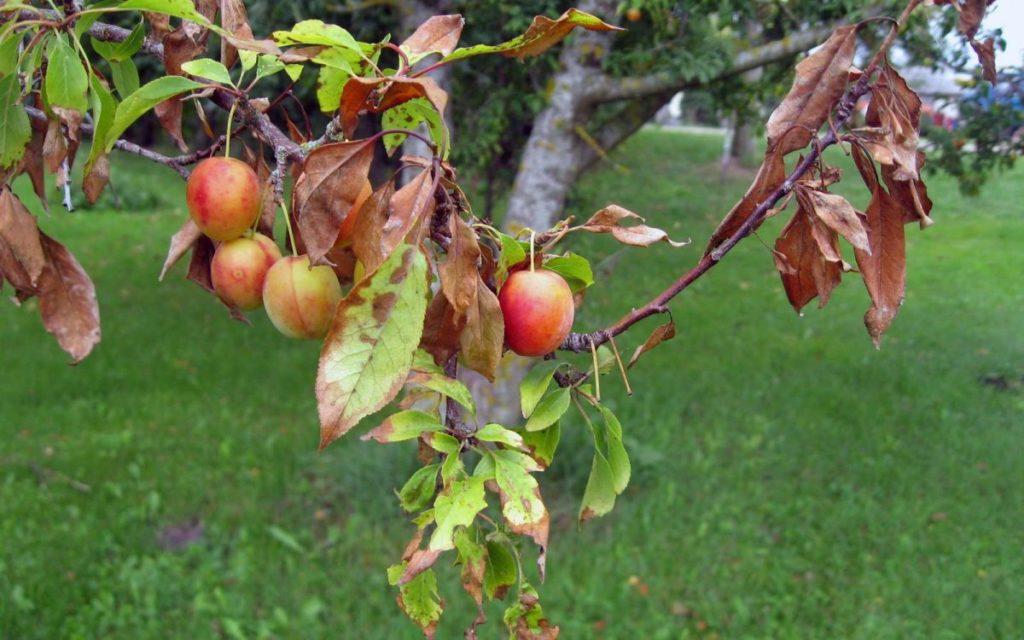
Clasterosporium disease
Fungal spores live in slices on shoots, buds. The pathogen is dormant in winter. Signs of fungus on leaves:
- brown spots with a raspberry border;
- the middle of the spots dries up and falls off;
- holes remain on the leaves.
The ridged leaf dries up and falls off.
Manifestation of disease on fruits:
- small red spots;
- marks increase, become convex;
- a resinous substance is released from the affected areas.
The fungus covers individual branches. They are covered with red spots. In the advanced stage, the bark cracks, the shoots dry up, and the tree dies.
For the treatment of plums, Bordeaux liquid is used:
- 1% solution - before the beginning of the growing season, during the budding period, after flowering and 3 weeks before the fruits ripen;
- 3% water solution - applied after the leaves fall in autumn, if the branch is badly damaged.

Clasterosporia is also treated with Horus, Topaz, Vectra. The processing is completed 20 days before the start of fruit collection.
Stone fruit moniliosis (gray rot)
The fungus hibernates on the branches and manifests itself in two stages:
- damage to branches - the bark becomes brown and darkens to the color of burning;
- decay of fruits - brown spots cover the entire surface, are covered with small round myceliums.
Sick branches and fruits fall off. Moniliosis begins in cracks in the bark and leads to the death of the tree.
How to cure a plum:
- cut off "burnt" branches;
- Tear off fruits with signs of rot;
- treat the tree with a 1% solution of Bordeaux liquid.
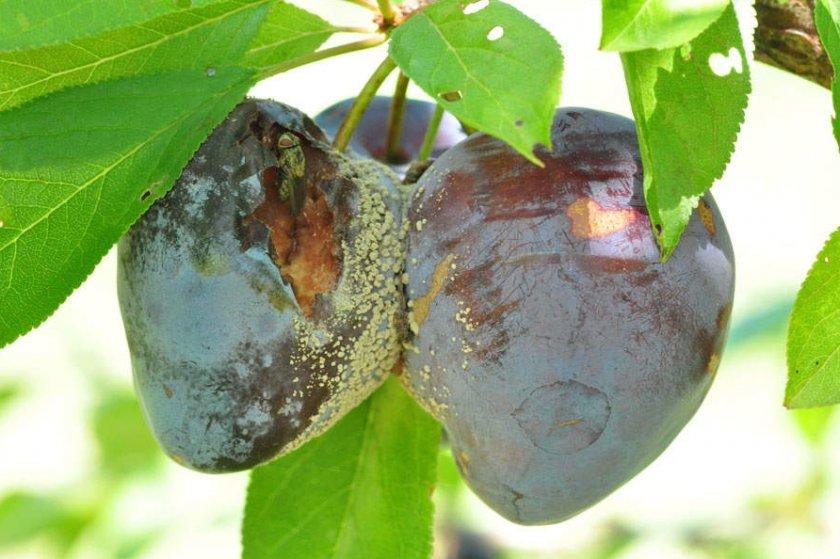
Before and after flowering plums, you need to spray with a 1% solution of iron or copper sulfate;
Witch's broom plum
The fungus that causes the disease settles in the crowns of trees and affects some of them.
Signs of a witch's broom:
- thin shoots without fruit;
- small pale green leaves with a scarlet tint;
- gray bloom.
The affected areas resemble a tangled panicle. Branches with pathology are cut off. In the spring, trees are treated with Bordeaux liquid: 3% solution before the buds open, 1% - before the fruit ovary.

Milky shine
The disease develops in spring on trees damaged by winter frost or late frosts.
The disease is recognized after the leaves have appeared. Signs:
- cavities under the skin of the leaves;
- silvery bloom;
- reddish-brown spots on the branch cut.
With the development of the disease, the leaves darken and dry out, and the branches and trunk are covered with leathery stripes. Sick branches are cut off. Places of cuts are treated with copper sulfate, oil paint.

Fruit rot
Fungal spores become active in damp conditions. A favorable time for their development is a rainy summer. Spores end up in fruits damaged by birds and insects. Signs of the disease:
- fast growing dark brown spot;
- gray-brown round myceliums with spores.
Affected fruits are harvested, burned or buried. Plums are sprayed with a 1% solution of Bordeaux liquid.
Plum tinder fungus
Plum or ginger tinder fungus is a fungus that causes rotting of the branches and trunk from the inside.
External signs:
- thick growths-caps;
- single formations, connected by thin bridges, or a continuous cover;
- the surface of the caps is smooth or cracked, brown or black.

The fungus appears on saw cuts, in crevices and frozen sections of the trunk. The infected tissue turns yellow, covered with red-brown stripes along the edges.Rotting rises up the trunk and sinks to the roots. The only cure is destruction. A small affected area is cut out and treated with garden varnish. A branch with a large mushroom is cut off. If the tree is densely covered with tinder fungus, it is dug up. The diseased branches and trunks are burned.
Sooty fungus
A symptom of the disease is a black bloom on the leaves, similar to soot. The tree becomes infected by insect pests. The disease interferes with photosynthesis.
To get rid of the sooty fungus, the tree is sprayed with a solution of soap and copper sulfate. For 10 liters of water, 100 grams of grated household soap and 5 grams of copper sulfate are required.
Scab
The fungus first appears on half-ripe fruits. Signs and course of scab:
- small blurry olive spots appear;
- green spot turns into dark, with clear contours;
- the fruit becomes crusty with cracks.

Scab must be treated with Skor, Raek, Horus. Affected fruits are removed before processing. Since the spores persist in the bark and leaves, re-infection begins in late summer.
Powdery mildew
If the plum leaves are covered with a white coating, then the tree is infected with powdery mildew. The fungus hibernates on tree trunks and in fallen leaves, and in spring it releases flour-like spores. A sticky bloom with small black myceliums appears on fruits and branches.
Fungicides are used against powdery mildew. After 14 days, repeat the spraying. For greater efficiency, change the means.
Lichen
The symbiotic organism of a lichen consists of a fungus and algae. The formation is fed by solid particles from the air and does not directly harm the drain. The lichen secretes substances that kill pathogenic microorganisms. Farmers believe that the fungus thallus traps moisture and creates a favorable environment for bacteria to multiply.
Lichen occurs on old trees with little bark growth. In a well-groomed garden with young trees, it does not exist, since a symbiotic organism cannot firmly gain a foothold on a growing branch.
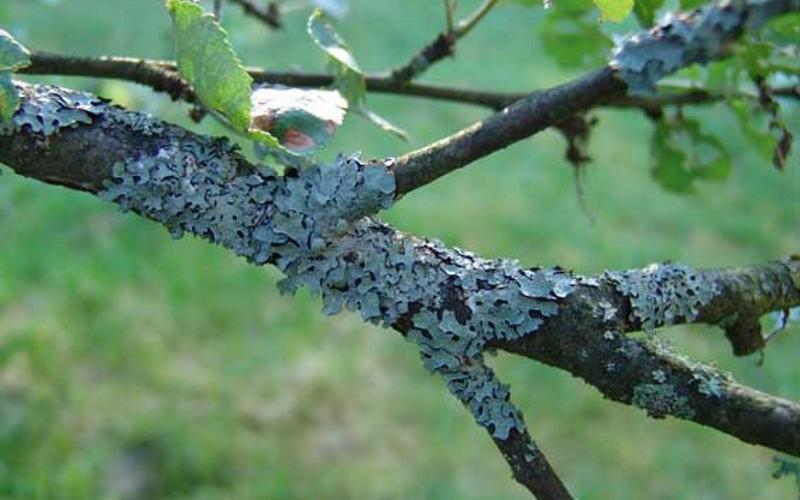
The appearance of a lichen on a young plum is a sign of inhibition of its growth due to errors in care, moisture due to surface groundwater or dense planting.
Infectious diseases
Plums become infected through dirty tools and pests. Plant infections are difficult to treat. Therefore, infected trees are immediately dug up and burned.
Plum Pox (Sharka)
The peculiarity of the disease is in the early ripening of the fruits. Signs are already visible on young leaves:
- light spots in the form of rings or lines;
- marble green color.
The skin of early fruits is also covered with curly stripes and spots. The flesh becomes bright red, hard and inedible. To recognize the disease at an early stage, you need to look through the leaves into the light. Then the curls are clearly visible.
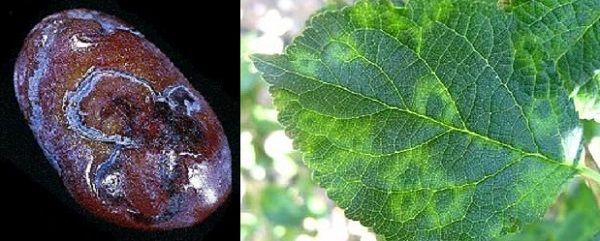
Timely control of smallpox of fruit plants is the main task of farmers, since the disease makes the crop unsuitable for sale and processing. Trees with signs of sharki are immediately destroyed.
Plum dwarfism
Signs of the disease:
- narrow, uneven leaves along the edges;
- the appearance of brown spots in greenery;
- deformed peduncles.
With an advanced form of dwarfism, the leaves become fragile and collect in bunches. Blooming stops. The tree does not grow and dies. The infection is not cured. To prevent the disease from spreading, the affected plum is dug up and burned.

Cytosporosis
The fungus infects damaged branches, penetrates through cracks in the bark. Neglect of sanitary pruning becomes a prerequisite for the disease. Under the influence of the fungus, plant tissue dies off, and black growths appear. The periods of cytosporosis spread are early spring and late autumn, when the trees are dormant.
The remedy for the disease is pruning damaged branches and a 3% solution of Bordeaux liquid.Trees must be cultivated before bud break.
Bacterial diseases
Diseases caused by bacteria are transmitted through soil and garden tools. Mature trees are also infected from purchased young seedlings.
Root cancer
Trees pick up disease from contaminated soil. Bacteria enter the microcracks in the roots. The root system is covered with growths. The tree does not receive food and dies.
The causative agents of root cancer live in slightly acidic soil and become active when there is a lack of moisture and high air temperatures. The affected plums are dug up, and the soil is disinfected with a solution of copper sulfate.

Bacterial burn
Signs of the disease:
- flowers are dark brown, fall off;
- young branches with dark watery spots, bending downward;
- black leaves curl;
- soft bark with amber resinous secretions.
The tree turns black, as if after a fire. In the advanced stage, the crust is covered with red cracks.
A solution of the fungicidal agent Azophos and an antibiotic will help fight the disease. Suitable antibacterial drugs:
- chloramphenicol;
- rifampicin;
- streptomycin;
- gentamicin.
The fungicide is diluted at a ratio of 500 grams per 10 liters, and the antibiotic is diluted at 50 milligrams per liter. Trees are treated before flowering, 3 times with a break of 4-5 days.

Non-communicable diseases
Diseases of the non-infectious type arise due to unfavorable environmental conditions, improper selection of fertilizers and as a result of other diseases.
Gum therapy
During gum removal, resin appears on the tree trunk. Causes of the disease:
- abundant watering, high humidity;
- increased acidity of the soil;
- open wet pruning areas.
Brown tears appear due to the application of a large amount of fertilizer. Trees also deteriorate from freezing. Wounds remain after formative and sanitary pruning. If the lesions are not disinfected with garden varnish, brown discharge appears on them, similar to burnt sugar.
How to deal with the disease:
- peel off the gum with a sharp, clean knife;
- lubricate the branch with a solution of copper sulfate 1%;
- grind fresh sorrel leaves and rub the affected area;
- process the bark with garden pitch.

The second name of the disease is gommosis. It is dangerous in that resinous areas become a favorable environment for further infection.
Shrinking
Plum dries up after planting in unsuitable conditions:
- with a surface location of groundwater;
- in alkaline soil, salt marsh;
- in a harsh climate with cold winters.
A sign of the condition is evenly dried, brown leaves, rolled into tubes. To stop drying out, it is necessary to create favorable conditions for the tree: reduce the acidity of the soil, transplant it to a dry, weather-protected place.

Prevention of plum diseases: calendar
Preventive disease control measures include in the seasonal gardening schedule:
- March, April - cut off damaged branches, clean and disinfect cracks in the bark with garden pitch. Before the buds open, plums are sprayed with a 1% solution of Bordeaux liquid, and with the appearance of greenery, with fungicides. Trunk circles are mulched with ash against insects;
- May, June - sprayed with insecticides against gnawing and sucking insects at the beginning of budding and with the appearance of fruit ovaries. For the prevention of clotterosporia, plums are treated with the fungicide Skor at the beginning and at the end of flowering. During flowering, trees are not sprayed;
- July, August - use insecticides and fungicides if pests or signs of disease appear;
- September, October - the garden is treated with preparations with copper, insecticides and fungicides after leaves fall.
Autumn spraying is carried out at temperatures above 0 degrees, in dry weather. In frost, the liquid freezes in microcracks in the bark and damages plant tissues. The soil of the near-trunk circles is also disinfected, since larvae and spores are hidden in it.
